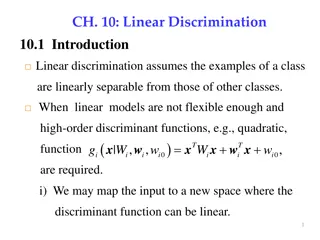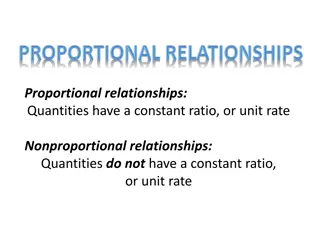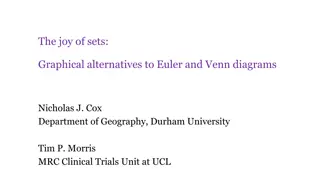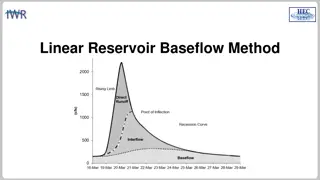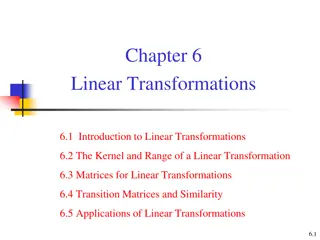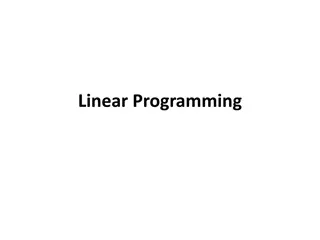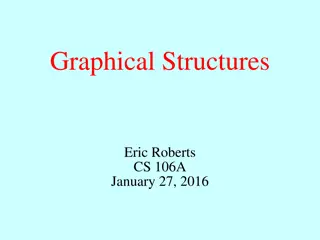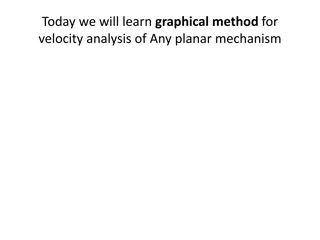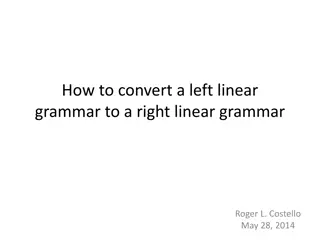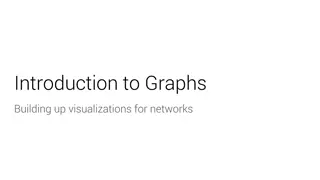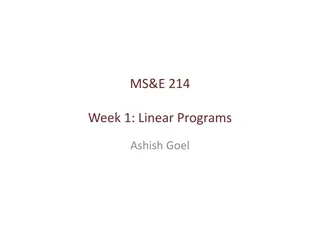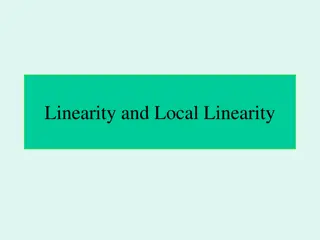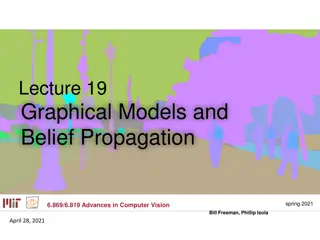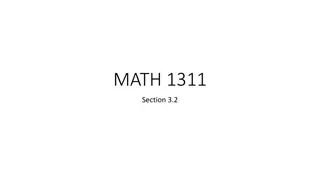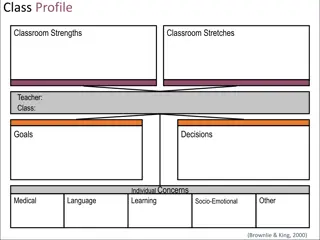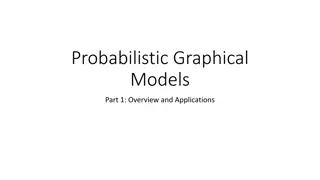Graphical representations of linear relationships
This material includes a series of checkpoint activities and additional tasks related to graphical representations of linear relationships for Year 8 students. Students will engage in tasks such as plotting points on coordinate grids, analyzing ant movements, exploring different rules for plotting points, and working with coordinates in a challenging yet engaging way. The content is designed to enhance students' understanding of linear relationships and improve their mathematical skills through interactive and thought-provoking exercises.
Download Presentation

Please find below an Image/Link to download the presentation.
The content on the website is provided AS IS for your information and personal use only. It may not be sold, licensed, or shared on other websites without obtaining consent from the author.If you encounter any issues during the download, it is possible that the publisher has removed the file from their server.
You are allowed to download the files provided on this website for personal or commercial use, subject to the condition that they are used lawfully. All files are the property of their respective owners.
The content on the website is provided AS IS for your information and personal use only. It may not be sold, licensed, or shared on other websites without obtaining consent from the author.
E N D
Presentation Transcript
Checkpoints Year 8 diagnostic mathematics activities Graphical representations of linear relationships Fifteen Checkpoint activities Eight additional activities Published in 2022/23
Checkpoints 18 Checkpoint Underpins Code 1: Ant moves again 2: Plotting rules 3: Awkward axes again 4: Three in a row 4.2.1 4.2.2 Coordinates and linear relationships 5: Thinking of a number 6: Odd coordinate out 7: Subject graphs 8: Inbetweeners again *This three-digit code refers to the statement of knowledge, skills and understanding in the NCETM s Sample Key Stage 3 Curriculum Framework (see notes below for more information).
Checkpoints 915 Checkpoint Underpins Code 9: For every 10: Staircases 11: Buckets 12: Stepping up Gradient and rate 4.2.2 13: Almost square? 14: Race to the centre 15: Gardeners time question *This three-digit code refers to the statement of knowledge, skills and understanding in the NCETM s Sample Key Stage 3 Curriculum Framework (see notes below for more information).
Coordinates and linear relationships Checkpoints 1 8
Checkpoint 1: Ant moves again An ant is on a coordinate grid. a) What coordinates is the ant on? b) Complete the sentence: The y-coordinate is __ times the x-coordinate. The ant moves to another point on the grid. The sentence is still true. c) What new coordinates might it be on? Redo parts a to c using this new sentence: The y-coordinate is __ more than the x-coordinate. How have your answers changed?
Checkpoint 2: Plotting rules Four people are given the same number. Asma trebles the number and adds 3. Bola halves the number and subtracts 1. Claire doubles the number and subtracts 1. Dave doubles the number and adds 1. S Three of them plot some points, using their starting number as the x-coordinate and the outcome of their calculation as the y-coordinate. a) Which point belongs to which person? b) Whose point was missing? Plot it for them. One person plots a new point, S, using the same rule with a different starting number. Who is it? Plot the other three people's coordinates using this new starting number.
Checkpoint 3: Awkward axes again Bix plots three coordinates: A, B and C. a) What might these coordinates be? Is there more than one answer? b) Sam says coordinate A is (-2, -2). Terri says it is (-2, -1). Why could they both be right? c) If coordinate C is (1, -1.5), what are the other coordinates? d) If coordinate B is (0, -40), what do we know about the other coordinates? Bix s coordinates form a straight line. If Sam was correct in part b, what are the coordinates of points B and C? What other coordinates could be on this line?
Checkpoint 4: Three in a row Ian and Alison are playing a game. The aim is to plot three coordinates in a row, then join them with a straight line so that the line segment does not crossthe other player s line segment. Alison s are the red crosses. Ian s are the blue circles. a) Where might Alison plot her third coordinate? b) Where might Ian plot his third coordinate? c) If the winner is the person with the longest line segment, who had the best strategy? Why? If both axes are extended to be from -10 to 10, would any of your answers change?
Checkpoint 5: Thinking of a number Gilbert is thinking of a number. Iris says that she will add two to whatever number he chooses. a) What could their numbers be? b) Plot some of your suggestions on the grid. c) What do you notice about your suggestions? d) How would your graph look different if Iris added five to Gilbert s numbers? e) How about if she subtracted three? Iris picks a new rule. One of coordinates she plots is (3, 6). What could her rule have been? What other coordinates might she plot using the new rule?
Checkpoint 6: Odd coordinate out On the right is a set of coordinates. a) Which set do you think is the odd one out? b) Plot the coordinates on the grid. c) What do you notice? Do you want to change your answer to part a? d) Repeat parts a to c for the two sets of coordinates below. (0, 2) (5, 6) (3, 5) (1, 3) (-1, 1) (0, 0) (4, 8) (2, 4) (-3, -6) (-1, 1) (0, 0) (-2, -4) (1, -1) (-1, -3) (2, 0) For each of the three sets of coordinates, change the odd one out so that they fit into the group.
Checkpoint 6: Odd coordinate out (animated solutions) x x x x x x x x x x x x x x x (0, 2) (2, 3) (3, 5) (1, 3) (-1, 1) (0, 0) (-2, -4) (2, 4) (1, 2) (-1, 1) (0, 0) (-2, -4) (1, -1) (-1, -3) (2, 0)
Checkpoint 7: Subject graphs In science, Tyler measures the height and arm span of people in his class. In maths, Tyler writes a list of coordinates where the x and y values are equal. a) Which graph is which? b) What is the same and what is different between Tyler s two graphs? Here are three more points: A (151, 150), B (251, 251) and C (151, 151). Which graph could points A, B and C belong to? Explain how you know.
Checkpoint 8: Inbetweeners again a) Think of a pair of coordinates that would be on the line between A and B. b) Think of two more pairs. c) Can you think of another one that no one else has yet? d) Think of a pair of coordinates between C and D that is not on the line between A and B. C B A D Can you think of a pair of coordinates that might be on the line between B and D?
Gradient and rate Checkpoints 9 15
Checkpoint 9: For every On Monday, Ali and Darren are unpacking boxes. For every two boxes Ali unpacks, Darren unpacks one. a) One person has unpacked five boxes. How many has other unpacked? x H Ali records how many boxes they unpack on a graph. She plots one point (G). b) Which axis is for Ali and which is for Darren? c) What other points could be plotted? x G On Tuesday, they unpack at different rates. The coordinate H shows this. d) Complete the sentence: For every four boxes Ali unpacks, Darren unpacks __. Each day, they need to unpack 100 boxes in total. On which day do they do this faster? How do you know?
Checkpoint 10: Staircases Some students are drawing staircase patterns across this piece of squared paper. Below are the beginnings of their patterns. Denis Benny Abdul Cara a) Whose pattern will reach the top of the page first? How do you know? b) Who will reach the top of the page next? Elsa Elsa starts her staircase pattern at the top left of the page. How could you complete it so that it is the same steepness as each of the other patterns?
Checkpoint 11: Buckets Nicki and Tim each fill a bucket. a) Whose bucket was filled faster? How do you know? b) Whose bucket was smaller? c) Where on the graph shows when Nicki s bucket was half full? d) Where on the graph shows when Tim s bucket was half full? e) Where on the graph shows when Nicki had twice as much water in her bucket as Tim? Volume of water in bucket (ml) Time (seconds) The capacity of Tim s bucket was four litres. Nicki filled her bucket in 45 seconds. Now you know this, what else do you know?
Checkpoint 11: Buckets (animated solutions for c-e) Nicki and Tim each fill a bucket. a) Whose bucket was filled faster? How do you know? b) Whose bucket was smaller? c) Where on the graph shows when Nicki s bucket was half full? d) Where on the graph shows when Tim s bucket was half full? e) Where on the graph shows when Nicki had twice as much water in her bucket as Tim? Volume of water in bucket (ml) X X Time (seconds) The capacity of Tim s bucket was four litres. Nicki filled her bucket in 45 seconds. Now you know this, what else do you know?
Checkpoint 12: Stepping up a) Put these steps in order from steepest to least steep. How do you know? b) Another set of steps join point X to point Y. Where would these steps go in your order of steepness? Draw some sets of steps that are steeper than E but not as steep as C.
Checkpoint 13: Almost square? Which is steeper? a) B to D or A to D? b) A to B or D to C? c) A to D or B to C? d) A to D or C to B? The shape ABCD is nearly square. Move one point so that it becomes square. How can you be certain that it s square?
Checkpoint 14: Race to the centre Jane and Ross are playing a game. a) What are their starting coordinates? Their teacher writes some different rules for how to move from a starting coordinate to the next coordinate. They each pick a rule and plot their next two coordinates. b) What might Jane s rule be? c) What might Ross s rule be? d) The aim of the game is to reach the origin first. Who will win? e) How could you change the other person s start coordinate so that they win? Jane starts here x x x x x x Ross starts here Dahlia picks a rule: right two, down one . Where could she plot her starting coordinate to be sure she gets to the origin? Is there more than one answer?
Checkpoint 15: Gardeners time question Two different gardeners work in the local park. They each buy some trees and flowers and then charge a set amount for each hour it takes to plant them all. a) Explain how you could use this graph to find out how much each gardener spent on plants. b) How could you use it to find out about their hourly rate? Gardener A Gardener B One of the gardeners says that the job will take 10 hours, the other says eight hours. How much would each gardener charge to complete the job?
Additional activities Activities A H
Activity A: Four in a row Franca and Mark are playing a game. The aim is to plot four coordinates in a row. a) What are Franca and Mark s first coordinates? The coordinate marked ? is the next coordinate plotted. b) If it is Franca s, what other coordinates might she be planning to plot? What do you notice about her coordinates? c) If it is Mark s, what other coordinates might he be planning to plot? What do you notice about his coordinates? Franca x x ? x Mark The third coordinate was Franca s. Is it possible for Mark to win? Continue playing the game with a partner and see if you can find a way for either Franca or Mark to win.
Activity B: Plotting rules Esme is given a starting number and adds four to it. She uses her starting number as an x-coordinate and her new number as a y-coordinate. a) Which of the coordinates given could be Esme s? b) Where else on the grid can Esme mark her position? c) What might be a coordinate that follows Esme s rule, but isn t on this grid? For the coordinates that weren t Esme s, how might the y-coordinate have been calculated?
Activity C: More odd coordinates out On the right is a set of coordinates. a) Which one do you think is the odd one out? b) Plot the coordinates on the grid. c) What do you notice? Do you want to change your answer to part a? d) Repeat parts a to c for the three sets of coordinates below. (0, 0) (-1, 1) (2, -2) (-3, -3) (4, -4) (0, 0) (2, 5) (1, 3) (-1, -1) (-2, -3) (0, 0) (-2, 4) (1, 1) (-1, 3) (2, 0) (0, 0) (-2, -1) (1, 2) (4, 2) (6, 3) Change the odd ones out in each set of coordinates so that they fit into the group.
Activity C: More odd coordinates out (animated solutions) x x x x x x x x x x x x x x x x x x x x (0, 0) (2, 5) (1, 3) (-1, -1) (-2, -3) (0, 0) (-1, 1) (2, -2) (-3, -3) (4, -4) (0, 0) (-2, 4) (1, 1) (-1, 3) (2, 0) (0, 0) (-2, -1) (1, 2) (4, 2) (6, 3)
Activity D: Plumbers Key: Plumber A Plumber B Julia is choosing between two plumbers. They each use a different rule to work out their pay. She plots the two rules on a graph. a) What is the same and what is different about the two rules? b) Which plumber do you think charges for their travel time? c) Which plumber costs more for three hours? How can you tell? Cost Create your own rule that would be more expensive than both plumbers before five hours, but cheaper after. Hours worked
Activity E: Roast dinners Sam is roasting a lamb joint. His recipe book gives two options for the cooking times, in minutes. Medium: Well done: 40 weight (in kg) + 20 50 weight (in kg) + 20 a) b) c) On the graph, what does the x-axis represent? What are the units for the two axes? What is the same and what is different about the two lines? How much longer would it take to cook a 4 kg lamb joint so that it is well done rather than medium? d) Sam wants to cook a 6 kg lamb joint. How could he use the graph to work out the cooking times?
Activity F: On the line The coordinates of point A are (37, 37), B (39, 39) and C (40, 40). The three points form a line. a) Write three more coordinates that will be on the same line. Points D, E and F also form a line. b) Write down three more coordinates that will be on this line. How do you know? c) Is it possible to answer part b so that one of the coordinate values is negative and one is positive? How do you know? Imagine a line drawn through A and E. Write down the coordinates of three points that will be on this line.
Activity G: Mark the points Three points are marked on a set of axes. A (-2, 12) B (10, 0) C (16, -6) yellow purple Write down the coordinates of a point: a) in the yellow (right-hand) section b) in the orange (left-hand) section c) in the purple (middle) section d) on the line formed by A, B and C. orange Write down some other points on the line. How do you know that your points must be on the line?
Activity H: Mathematical Mondrian Piet draws some lines on a set of axes. All the lines are vertical or horizontal. The coordinates of the points marked are: A (4.5, 2.8) C (8, 8) G B (4.5, 8) D (-1.6, -1.7) F a) Write down the coordinates of a point in each of the blue (E), green (F), red (G) and purple (H) sections. b) Are you able to give the coordinates of any of the other vertices of the coloured sections? E H If you know these points, what other points do you know? Can you identify the coordinates (either complete or partial) of any other intersecting lines?
Denis Benny Abdul Cara Elsa Elsa starts her staircase pattern at the top left of the page. How could you complete it so that it is the same steepness as each of the other patterns? Denis Benny Abdul Cara Elsa Elsa starts her staircase pattern at the top left of the page. How could you complete it so that it is the same steepness as each of the other patterns?
Key: Plumber A Plumber B Key: Plumber A Plumber B Cost Cost Hours worked Hours worked



